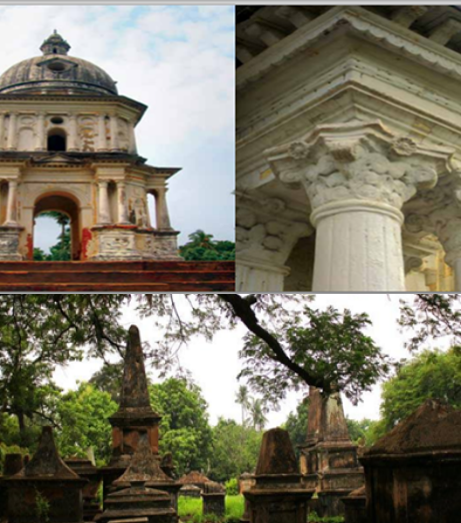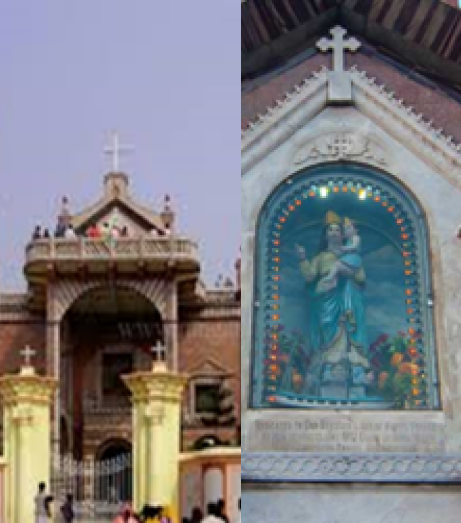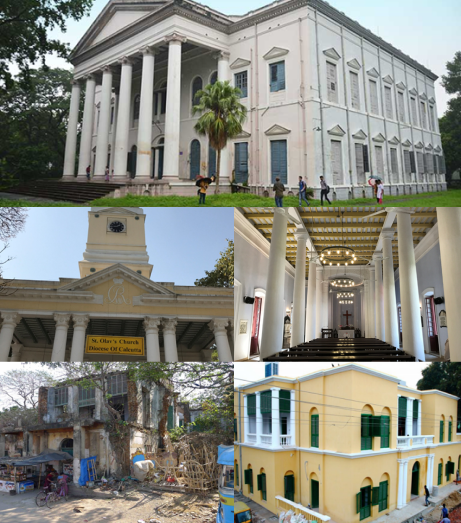Across the River Hooghly, one can still see footprints of various European countries that had created their own unique settlement, to facilitate trade through Calcutta’s Port. For those not too familiar with Bengal’s early history, a visit to the area is a real treat as one can see the influence of various European cultures, along the banks of the Hooghly River, creating the proverbial ‘Little Europe’. Rampant with historical influences of the British, the Dutch, the Danes, the Portuguese and the French, these areas of global influence weave a breathtaking portrait. The ‘Little Europe’ is still one of the best-kept secrets of Bengal.
The colonial remains on the banks of the Lower Ganges takes you back to a simpler time and makes you wonder how the trade and culture used to be. It all started when in circa 1498, Vasco da Gama, the Portuguese explorer, set foot in the area. As the Portuguese’s interests in the trade routes increased, they built a settlement in the Bandel . Soon after that came the Dutch in Chinsurah, the Danish in Serampore and the French in Chandannagar. This was long before the British had any interest, in India and its trade routes.
With more Europeans settling in the Lower Ganges area, trade flourished thus attracting the attention of more Europeans. Fortified settlements started coming up. With more houses and storehouses came Europeans who decided to settle there. This eventually led to the construction of churches and other places of worship. With the passage of time cemeteries were built to lay to rest those who had made Little Europe their home.

The First Glance of Europe on the Ganga
The First Glance of Europe on the Ganga
It was around 1599, roughly a hundred years after the first Portuguese set foot in the Lower Ganges, that the Portuguese built the first Christian Church of Bengal. About thirty years after its construction, in 1632, Shah Jahan, the Mughal Emperor of India, attacked the settlement, destroyed it and took its head priest, Father Joan De Cruz, prisoner. He was thrown in front of an elephant to be killed, but the elephant is said to have, instead, lifted him on its back.
Shah Jahan was impressed by this incident and decided to pardon the Portuguese traders. He gave them land as a gift for them to build their churches and expand their settlements. In 1673, the French settlers in Chandannagar received permission from yet another Mughal Subedar, Ibrahim Khan, to establish a French trading port on the Hooghly. For a short while, Chandannagar became a major European trade centre.
In 1825, the Dutch settlement in Chinsurah was destroyed when the British came to India and demolished the Dutch Fort of Gustava. Over the years, many churches, clock towers, and trade buildings of the Dutch were destroyed by the British. However, the Dutch cemeteries constructed under the ancient trees survived. The earliest grave in this cemetery is said to date back to 1743.
Rich architecture still stands strong in the Portuguese stronghold- Bandel
When the Portuguese arrived in Bengal, the Mughals were the rulers of India. When the Portuguese began trading in the Lower Ganges area, they never obtained permission from the Mughals .Trade continued to grow, and the region flourished both in trade and culture.The Mughals took notice of these events and started becoming wary.
After the Shah Jahan and Father Joan De Cruz incident, there was another incident that is still spoken of fondly in association with the Portuguese settlements in the Lower Ganges. A local Christian named Tiago tried to save the statue of Mother Mary during a siege. In a desperate attempt, he jumped into the Hooghly river with it. No one could find either Tiago or the statue, but when the church was finally inaugurated, the statue was found on the river bank.
The Portuguese were so elated by the heroic feat of Tiago saving the statue of Mother Mary that they decided to use that very statue in the church. They named it “Our Lady of the Happy Voyage”. While this inauguration was in progress, it is said that another miraculous incident took place. A storm-borne Portuguese ship, tattered and shattered, reached the banks of the Hooghly river where the Portuguese had settled. It is said that the Captain of the ship prayed to the Gods and vowed that if the ship survived the storm, he would offer its mast to the first church that they encountered. He stayed true to his vow and offered the mast to the church where it resides till today. The Portuguese translation for mast is ‘bandel,’ and so the Portuguese named this church the Bandel Church. Subsequently this entire area and later township came to be known as Bandel.

Rich architecture still stands strong in the Portuguese stronghold- Bandel

The Dutch dotted the Lower Ganges with historical wonders.
The Dutch dotted the Lower Ganges with historical wonders.
In 1615, the Dutch settled in Chinsurah of present West Bengal. Today, the town of Chinsurah is just like any other small and unplanned town of India. However, back in the days of the Dutch, Chinsurah was considered as one of the most beautiful towns. Fort Gustava was one of the prime attractions of Chinsurah and was also responsible for the flourishing Dutch trade on the riverfront of the Dutch East India Company.
In 1825, after nearly 200 years the Dutch traded Chinsurah for the island of Sumatra with the British. In 1914, the British constructed the Chinsurah Clock Tower. It was constructed in honour of the British Emperor Edward VII, and even houses two medallions and two plaques of him. Due to the British takeover, Chinsurah buildings have a touch of Dutch and British influences, along with indigenous designs.
The District Court, the Hooghly Madrassa, the Dutch Villa, the Dutch Church and the Hooghly Mohsin College are all remnants of the Dutch influence in the Lower Ganges. There is also the Dutch Cemetery, which is now a protected heritage site. Hooghly Collegiate School established in 1812, is the oldest European styled school in eastern India and bears testimony to the Dutch- English- Bengali confluence.
Educational and Reformative Buildings were the works of the Danes
The Danes came into the picture, around 1752. The Danish colony was maintained in present-day Serampore. Three missionaries are the most mentioned whenever the Danish settlement in the Lower Ganges is discussed. Joshua Marshman, Willaim Ward and William Carrey worked tirelessly to spread the cause of education and to reform the ways of the Danish society in the Bhagirathi- Hooghly area.
Their efforts bore fruit and in 1800, the Serampore Mission Press was established. It not only printed thousands of copies of the Bible translated into Bengali, but it also printed the Bengali translations of the Ramayana and the Mahabharata. The press became famous, and their readership kept multiplying. They soon released two newspapers- Friends of India in English and Samachar Darpan in Bengali.
Education was always at the forefront of the Danish efforts and they also constructed Serampore College, the oldest degree college in Asia. After constructing several Danish-influenced buildings, the Danish Governor sold Serampore to the British East India Company. Recently, Denmark took an interest in their heritage in Bengal and restored a Tavern at Serampore. This place now serves as a great spot for tourists to have a splendid meal.

Serampore College, St Olav’s Church, Denmark Tavern, 1786, recently restored

Serampore College, St Olav’s Church
The many delights of the French Colonies in Chandannagar continue to thrive
The French arrived in the Lower Ganges area about 60 years after the Dutch and the Danes. However, the French could never be driven out of their French colonies in the Lower Ganges even when the Dutch, the Danes, the Germans, the Austrians, and even the Portuguese were driven out by the British. The French colonies along the Bhagirathi- Hooghly continued to flourish even after Indian Independence up until 1950.
The French settled down in Chandannagar, ten kilometres from the Portuguese settlement of Bandel. The most famous tourist attraction of Chandannagar is the Strand,located along the Hooghly which boasts heavily of French architecture. The Sacred Heart Church is not far from the Strand and is famous for its stained glass windows. Located nearby is the mansion of a former French commander. It has now been converted into the Chandannagar Museum and Institute.
The French not only indulged in their French architecture but also built many temples. However, only a few of these temples survive in the present day. Many memorabilia and artefacts can be found in the Chandannagar Museum and Institute, also referred to as “Institut de Chandennagor”.If you get in touch with the locals, they will guide you to ancient French bakeries in Chandannagar that still bake bread the old-fashioned French way!
In a nutshell, this small patch of land, affectionately called ‘Little Europe in Bengal’ garnered a sense of Europe in its totality among generations of Bengalis. Bengali revolutionaries who were struggling against the British Empire often took refuge in these non-British territories to avoid arrest.
Little Europe has started attracting various European nation states to have a closer look at the somewhat forgotten territories they had once occupied. The early twenty-first century has brought back Dutch historians to Chinsurah, allowing them to have a closer look at their forgotten Dutch- Bengal style of painting and architecture. The National Museum of Denmark, under a project named ‘Serampore Initiative’, has plunged into one of the biggest urban conservation projects taken by a European state outside Europe’s territorial outreach in recent times. Renewed international interests are manifold, leading to the unearthing of many historical nuances and exploration of contemporary narratives. Little Europe on the Ganges continues to be an evolving point of convergence between Europe and South Asia.

